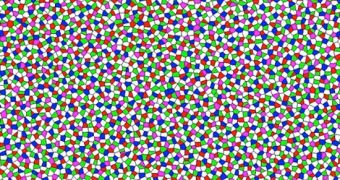In a paper published in today's issue of the journal Physical Review E, researchers detail the discovery of a biological occurrence of a fairly odd state of matter in the eye of a chicken.
What's more, they say that, up until now, this state of matter, called disordered hyperuniformity, has never before been documented in biology.
In their report, the scientists who worked on this research project detail that they stumbled upon said arrangement of matter while investigating how light-sensitive cells dubbed cones are arranged inside the eyes of such birds.
They go on to detail that, at first, they assumed that the five types of cones of different sizes that their analysis focused on were arranged in a rather hectic manner on the retina.
However, once they pieced together a computer model intended to mimic their arrangement, they found that these cones were actually positioned according to a pretty tidy configuration.
As detailed on the official website for the Princeton University, each of the cones present on the retina inside a chicken's eye has a so-called exclusion zone around it.
What's more, cones belonging to a certain type do not allow others of its kind to get too close, and instead allow cones of a different type in their proximity.
Thus, each cone has its own uniform arrangement. However, when the five different patterns overlap, the result appears disordered.
“It turned out that each type of cone has an area around it called an 'exclusion region' that other cones cannot enter.”
“Cones of the same type shut out each other more than they do unlike cones, and this variant exclusion causes distinctive cone patterns,” Princeton University's website reads.
Furthermore, “Each type of cone's pattern overlays the pattern of another cone so that the formations are intertwined in an organized but disordered way – a kind of uniform disarray.”
“So, while it appeared that the cones were irregularly placed, their distribution was actually uniform over large distances. That's disordered hyperuniformity.”
By the looks of it, in the case of materials, such an arrangement of particles, i.e. one that appears disorganized over small distances but that nonetheless has a hidden order, allows for crystal- and liquid-like behavior.
“Like crystals, these states greatly suppress variations in the density of particles – as in the individual granules of a substance – across large spatial distances so that the arrangement is highly uniform,” researchers say.
Otherwise put, they maintain a consistent density of particles across large spatial distances.
“At the same time, disordered hyperuniform systems are similar to liquids in that they have the same physical properties in all directions.”
“Combined, these characteristics mean that hyperuniform optical circuits, light detectors and other materials could be controlled to be sensitive or impervious to certain light wavelengths,” specialists explain.

 14 DAY TRIAL //
14 DAY TRIAL //